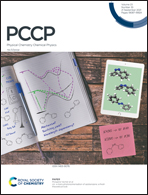Improving the theoretical description of Ln(iii)/An(iii) separation with phosphinic acid ligands: a benchmarking study of structure and selectivity†‡
Abstract
The efficient separation of trivalent lanthanides from minor actinides with soft-donor ligands, while showing experimental promise, has theorists continuing to search for suitable approaches for describing and interpreting selectivity. To remedy this, we employ several computational methods in describing the structure of model M(H2PX2)3 complexes, with M = Eu and Am, and X = O, S, Se, and Te, and predicting the selectivity of model phosphinic acid ligands in Eu(III)/Am(III) separation. After first establishing a set of MP2 and CCSD(T)-DKH3 results as benchmarks, we evaluate several density functionals and descriptions of valence shells for their accuracy with respect to metal–ligand bonding and selectivity. We find that commonly employed functionals with a 0–27% range of exact exchange used with small-core effective core potentials or with an explicit treatment of the relativistic effects (DKH2) incorrectly predict a decrease in the metal–ligand bond distance in going from Eu(III) to Am(III) and completely fail to track a selectivity trend, even giving a wrong sign for some or all ligands. Surprisingly, when these functionals are used in conjunction with an f-in-core description of metal ions, the correct trend in selectivity is recovered, though Am–X distances are overestimated in relation to Eu–X. Functionals with high components of exact exchange (50%) and double-hybrid functionals are reasonably aligned with benchmark results, pointing to the problems of DFT with small exact exchange fractions to handle f-electrons. Natural bond orbital analyses reveal that these poorly performing functionals disproportionately overpopulate outer f orbitals in the model complexes. We anticipate that recommendations resulting from this work will lead to more accurate theoretical descriptions of lanthanide/actinide selectivity with soft-donor chalcogen-based ligands in the future.



 Please wait while we load your content...
Please wait while we load your content...
